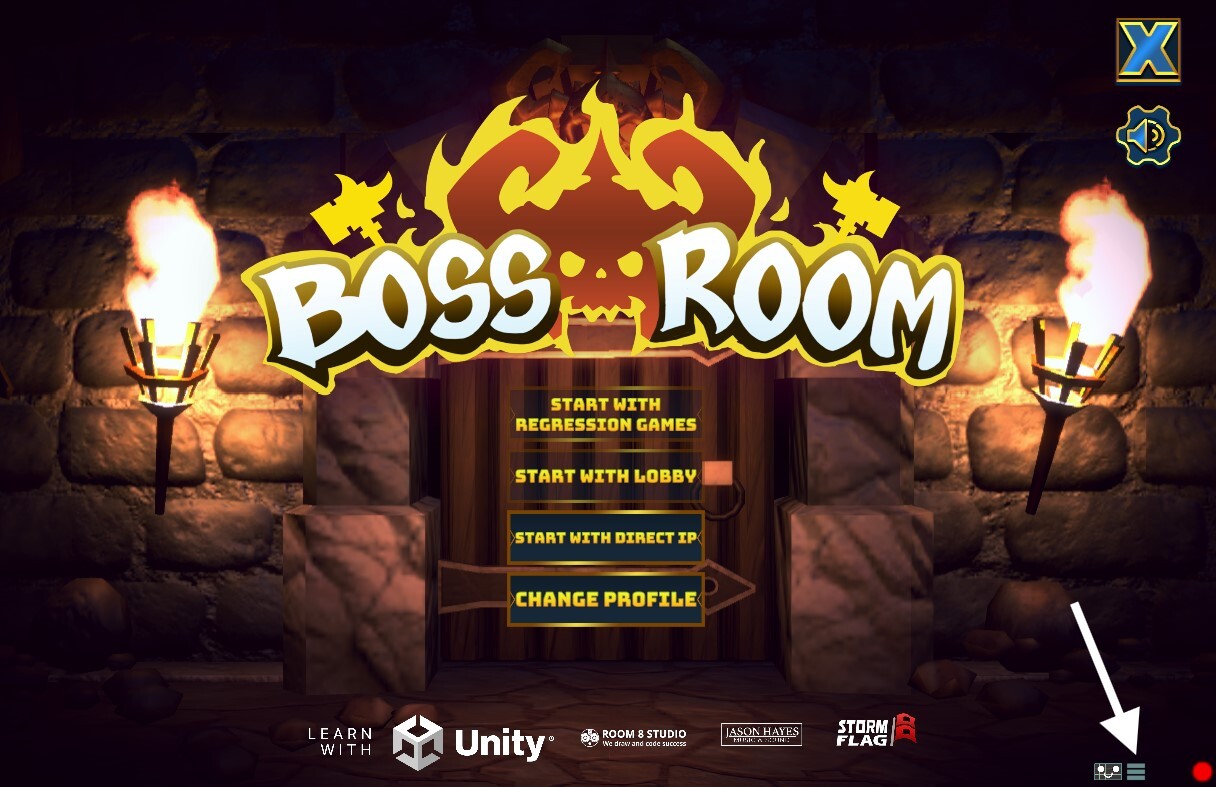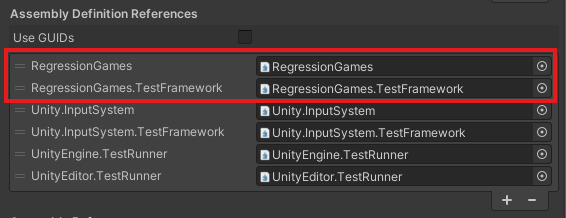Recording Gameplay
The RGOverlayCanvas allows you to record game state and user inputs as you play through your game. This information can be used to automatically replay the scenario, validate game behaviour with Validation Suites, and form the basis of complex Bot Sequences.
At a high level, the SDK captures the following information during gameplay:
- Entities and their state (e.g. position, behaviours, colliders)
- Performance information (e.g. frame rate, memory usage)
- User input (e.g. keyboard, mouse, gamepad)
- Screenshots
The SDK captures this information once every tick. A tick is a snapshot of the game state at a given point in time. One or more frames may elapse between two ticks, depending on the configured tick interval. Ticks are important to understand when working with the SDK, as they are used to visualize changes in the game state over time.
Creating a Recording
Recording requires the RGOverlayCanvas to be present in your scene.
Press the Record icon in the RG Toolbar while in "Play" mode to start recording gameplay. The icon will pulse to signal that a recording is in progress, and our SDK will begin capturing game state and user inputs.

Click the Record icon again to stop the recording and save captured data to your local device. If you have provided a valid API Key in the RG Settings, then a copy of the captured data will also be uploaded to your Regression Games account as a Gameplay Session. Gameplay Sessions unlock access to more features through the Regression Games web interface such as Validation Suites.
Recorded Data Formats
The SDK saves recordings to the temporary path on your local device specified by Application.persistentDataPath/RegressionGames/recordings.
Recordings are saved in these project specific directories as a folders named recording_{MM-dd-yyyy_HH.mm.ss}_{sessionId}.
Here is an example of a recording's location for a project with settings of Company Name: "MyCompany" and Product Name: "MyGame" ...
# macOS & Linux
~/Library/Application Support/MyCompany/MyGame/RegressionGames/recordings/recording_08-30-2024_14.34.13_0b8551
# Windows
C:\Users\{MyUser}\AppData\LocalNow\MyCompany\MyGame\RegressionGames\recordings\recording_08-30-2024_14.34.13_0b8551
A recording folder contains multiple files that provide important context about the game's state. This data is also saved to the Gameplay Session that is uploaded to your Regression Games account at the end of a recording. Expand the sections below to learn more about our raw data formats.
Replaying Recordings
Replaying a recording reproduces each tick in the original recording in order. This involves simulating inputs from the original recording and waiting for key values in the game state to match expectations set by the recorded tick before continuing to the next set of inputs. The SDK records the state of the game while a replay is in progress, and saves the replay data as a new recording and Gameplay Session.
Replay, and recording the replay, can be useful for identifying areas of your game that behave inconsistently given the same inputs, reproducing transient bugs and collecting debug information for them, or ensuring that changes to your game don't break gameplay.
Replaying a recording file works best in deterministic or mostly-deterministic scenarios. For example, navigating menus tends to be deterministic, while the locations and movements of NPCs may not be. The replay tool attempts to account for some inconsistencies, but it is not perfect. For games with a high degree of randomness or non-determinism, we recommend using recordings as a basis to create your own customized Bot Sequences rather than relying on raw recordings themselves.
Starting a Replay
There are two ways to initiate replay of an existing recording: manually select a recording via the overlay, or programmatically start a recording using utilities from our SDK.
Manual Replay
Press the Menu icon in the RG Toolbar while in "Play" mode to select a recording to replay.
This will launch a file explorer at the location of the recordings directory on your device.
Navigate into the folder of the recording you'd like to replay, select its bot_segments.zip file, and then click Load Replay.

Ctrl+Shift+F9. Use the same shortcut to resume.Stop by pressing the Stop icon or using the shortcut
Ctrl+Shift+F10. Stopping a recording will save the replay up to that point.Programmatic Replay
The RGTestUtils class provides methods for replaying recordings programmatically.
This is intended for use in
Play Mode tests for the Unity Test Runner.
The RegressionGames and RegressionGames.TestFramework assemblies must be listed as
references in your test assembly to use the RGTestUtils class.

By default, recordings are saved outside your project. Make sure you copy the recordings you'd like to replay into your project to ensure they'll be available on other machines that run these automated tests.
Create a UnityTest that invokes the RGTestUtils.StartPlaybackFromZipFile method.
Pass the path to your recording's bot_segments.zip file.
This will replay the recording, wait until playback is complete, and then save the replay as a new recording.
You can add additional logic to your test to validate the game state at the end of playback,
or use a recording to reach a known state in your game for further testing.
The PlaybackResult object contains the path to the new recording, but may be null if playback fails.
using System.Collections;
using RegressionGames;
using RegressionGames.Types;
using UnityEngine.Assertions;
using UnityEngine.SceneManagement;
using UnityEngine.TestTools;
public class RecordingTest
{
[UnityTest]
public IEnumerator TestRecording()
{
// Unity has a macOS bug that prints errors when taking screenshots during recording.
// This line prevents the test from failing when these errors are logged.
#if UNITY_EDITOR_OSX || UNITY_RUNTIME_OSX
LogAssert.ignoreFailingMessages = true;
#endif
// Define which recording to use
string recordingPath = System.IO.Path.Combine(System.IO.Directory.GetCurrentDirectory(), "Assets/Tests/Runtime/Recordings/MainMenuRecording.zip");
// Wait for the scene to load
SceneManager.LoadSceneAsync("Startup", LoadSceneMode.Single);
yield return RGTestUtils.WaitForScene("MainMenu");
// Start playback
// This will automatically create a new recording of the replay
PlaybackResult playbackResult = null;
yield return RGTestUtils.StartPlaybackFromZipFile(recordingPath, result => playbackResult = result);
// Print out the recording path for viewing later
Assert.IsNotNull(playbackResult);
Assert.IsNotNull(playbackResult.saveLocation);
RGDebug.LogInfo("Successfully replayed the recording and saved new recording to " + playbackResult.saveLocation);
}
}
Game State Errors During Replay
The replay tool reproduces user inputs from the original recording and waits for key values in the game state to match those in the recording. If the game state does not meet expectations set by the original recording after a certain timeout, then the SDK will pause replay and display a warning above the RG Toolbar with the list of unmet expectations. Replay will continue from where it left off if the warning is resolved.

Advanced Configuration
Adjusting the Recording Interval
The Recording Min FPS value controls how often the SDK scrapes the game state and captures that data as a tick.
This option can be found under the ScreenRecorder component attached to the RGOverlayCanvas GameObject in your scene.

The default value for this setting is 0, which means the SDK will capture a tick whenever it detects an important change in the game state.
Allowing the SDK to determine key state changes is sufficient for most games,
but you can set a regular interval for capturing ticks instead by adjusting the Recording Min FPS value on the ScreenRecorder component.
Setting the value above 0 will cause the SDK to record that many ticks each second.
Including and Excluding GameObjects from Data Capture
The SDK captures data for all GameObjects in the scene hierarchy that are visible to the camera. This can result in a lot of data being captured every tick, depending on the complexity of your scene.
You can exclude a GameObject from being captured by attaching the RGExcludeFromState component to it.
Excluding a GameObject will also exclude its children from data capture.
This can be useful for ignoring entire regions of a level or individual objects that are not relevant to your testing scenarios.
You can include GameObjects that are not visible to the camera or otherwise not rendered by adding the RGIncludeInState component to them.
This can be useful for always capturing data for important objects, regardless of whether they appear on-screen.